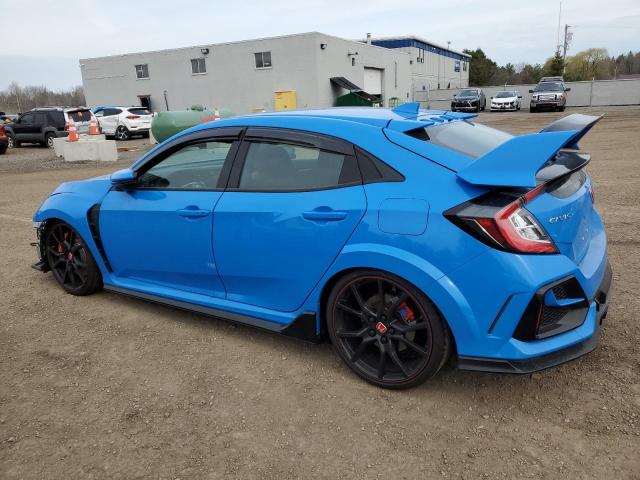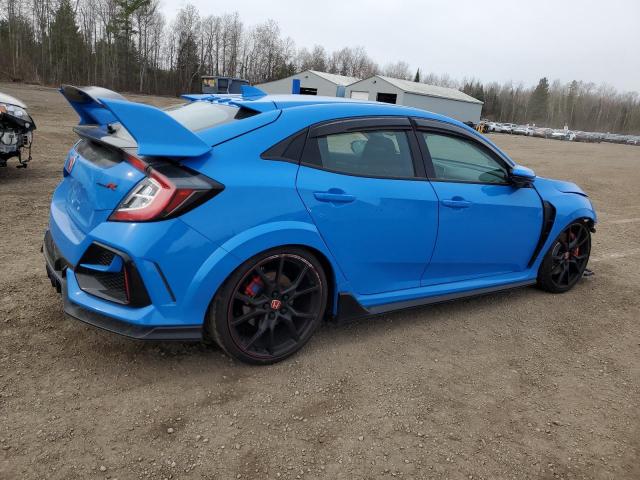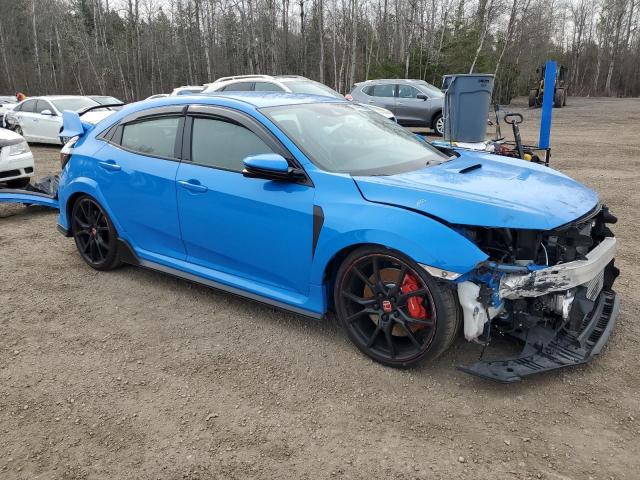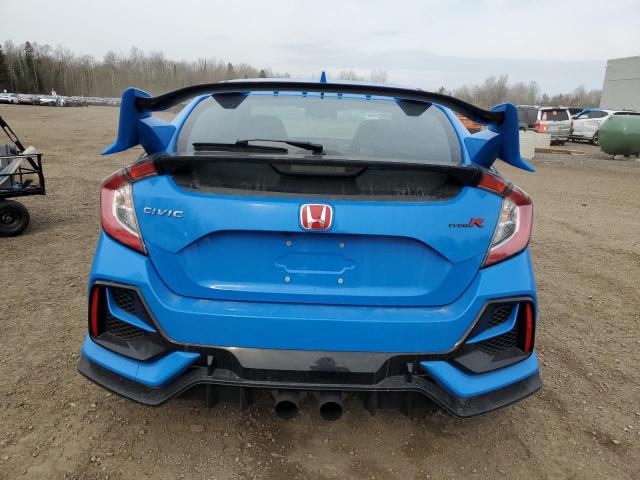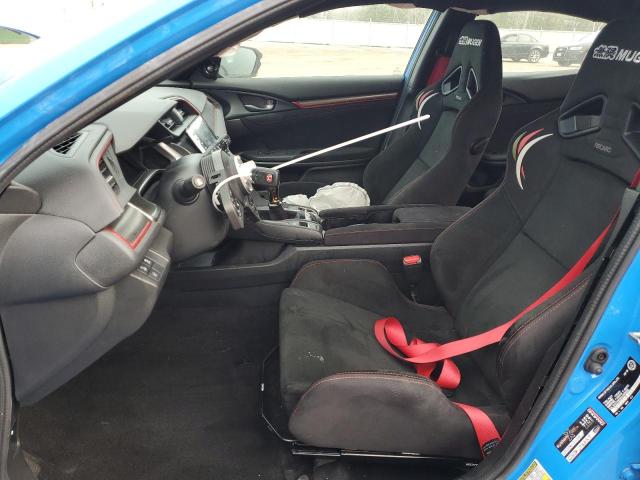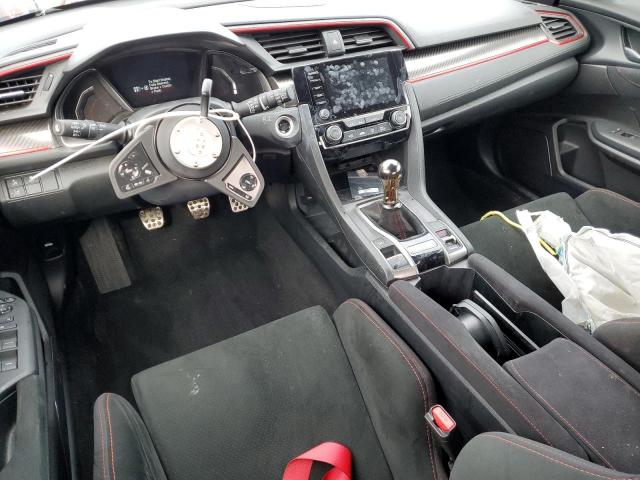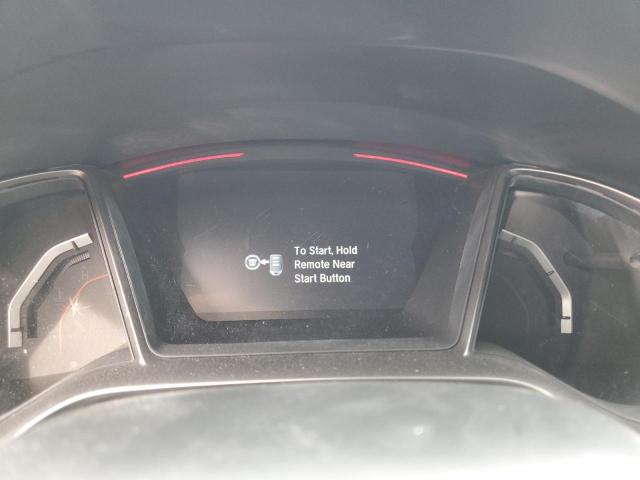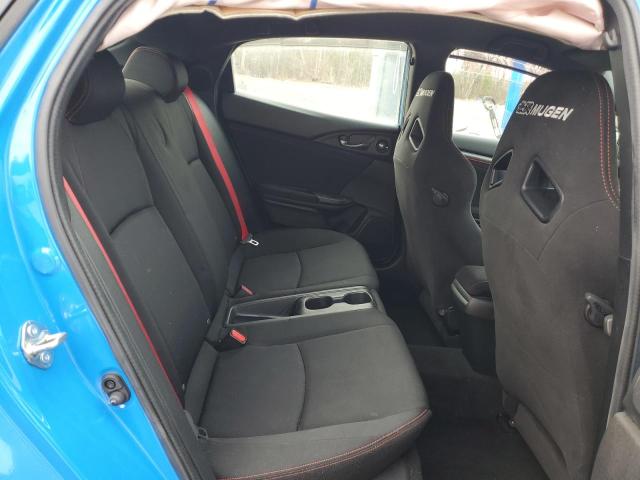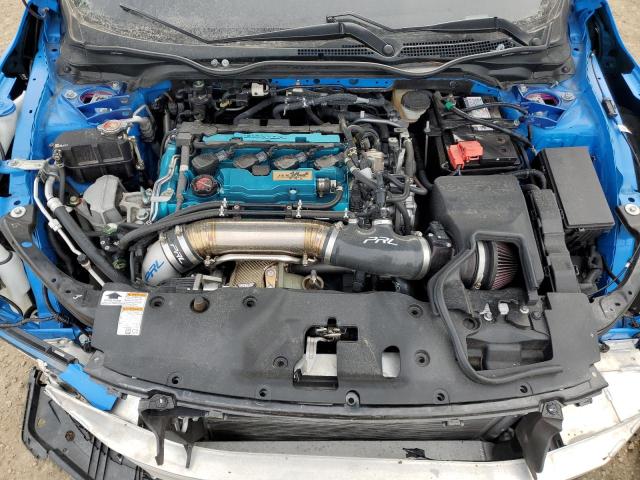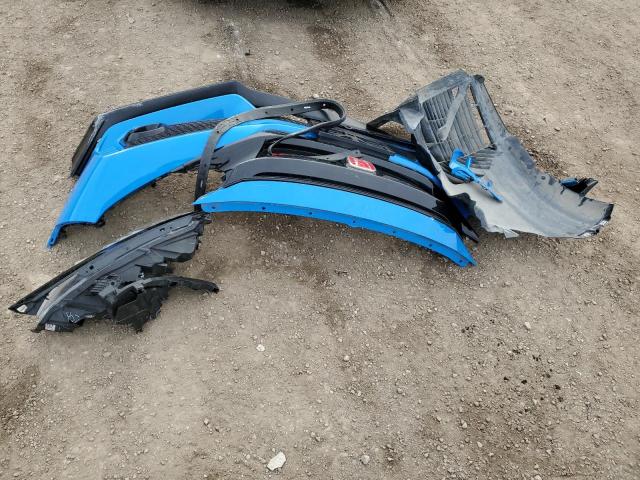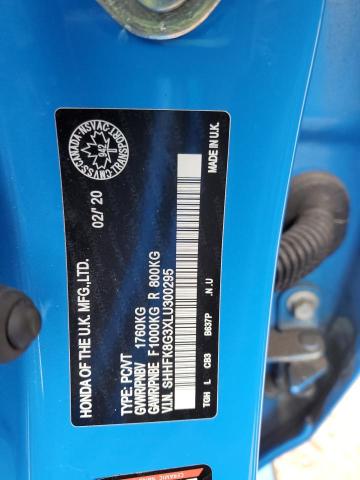2020 HONDA CIVIC TYPE R | SHHFK8G3XLU300295
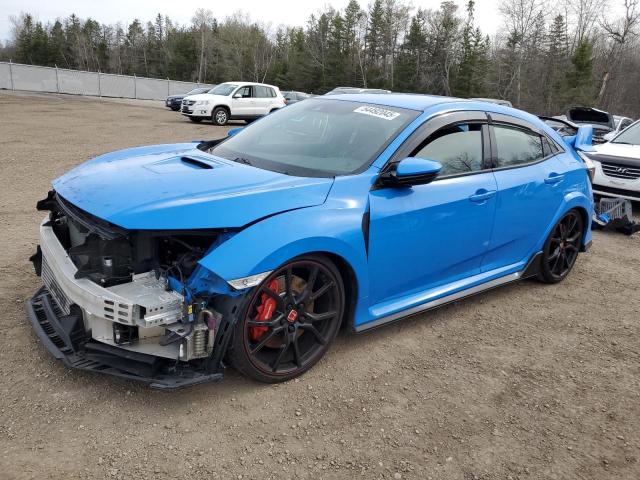 ❯
❯
Specifications
1
~$45,000
Engine: 2.0L turbocharged I4
Torque: 400 Nm
0–100 km/h: ~5.7 s
The Civic Type R redefined what a front-wheel-drive performance car could achieve. Its 2.0-liter turbocharged inline-4 engine delivered 306 horsepower and 400 Nm of torque through a precise, close-ratio 6-speed manual transmission with automatic rev-matching. This allowed the FK8 Type R to accelerate from 0 to 100 km/h in 5.7 seconds — with minimal torque steer thanks to its dual-axis front suspension and mechanical limited-slip differential.
Chassis tuning was nothing short of benchmark-setting. With adaptive dampers, a wide track, lightweight components, and extreme torsional rigidity, the Type R cornered with immediacy and balance usually reserved for rear-wheel-drive sports cars. Brake feel was sharp and fade-resistant thanks to standard Brembo four-piston calipers, and the steering was direct with superb feedback. The adjustable suspension modes — Comfort, Sport, +R — allowed the car to transform from daily driver to track weapon with the press of a button.
More than just speed, the Type R delivered engagement. It wasn’t merely fast; it was communicative, fluid, and brutally efficient. On track or winding roads, it embarrassed many more expensive performance cars while remaining practical and fuel-efficient on daily drives. The FK8 didn’t just revive the Type R badge — it turned it into a global performance icon.
Body Styles
The Civic Type R FK8 was available exclusively as a five-door hatchback, combining aggressive styling with real-world versatility. Its body featured dramatic aerodynamic sculpting, including a large rear wing, functional hood scoop, vortex generators on the roof, front air curtains, wide-body fenders, and a massive rear diffuser housing triple center-exit exhaust tips. The wide stance, extended rocker panels, and low front splitter made it unmistakably performance-focused. Despite its flamboyant appearance, every exterior element served a functional role in aerodynamic stability, cooling, or downforce. The long roofline and rear hatch preserved the Civic's practicality with usable rear headroom and ample cargo space.
Model Name Meaning (Manufacturer)
“Type R” stands for “Type Racing,” a badge Honda reserves for its most performance-focused, track-capable models. The name signifies a direct link to Honda’s motorsport engineering and heritage, with roots tracing back to the NSX Type R and original Civic Type R in the 1990s.
Body & Interior Colors and Rims
Exterior paint choices for the Civic Type R included signature colors like Championship White, Rallye Red, Sonic Gray Pearl, Crystal Black Pearl, and Boost Blue (introduced later). Championship White linked the model directly to Honda’s racing legacy, while Polished Metal Metallic and other muted tones balanced visual aggression with subtlety. The body featured gloss black accents on the grille, mirror caps, wing supports, and air intakes, along with red badging and Type R emblems that distinguished it from standard Civic trims.
Inside, the cabin combined race-inspired features with everyday comfort. Deeply bolstered red-and-black suede sport seats with Type R embroidery kept occupants in place during hard cornering. Red seatbelts, alloy pedals, carbon-fiber look trim, and a serialized build plate reinforced the car’s special status. The flat-bottomed steering wheel, metal shift knob, and minimalist instrumentation with red accents prioritized the driving experience. Despite its focused demeanor, the Type R offered dual-zone climate control, Apple CarPlay, a 7-inch touchscreen, and an excellent rear seat with class-leading space for a hot hatch.
The Type R came standard with lightweight 20-inch piano black alloys wrapped in 245/30ZR20 Continental SportContact 6 tires. Later models introduced forged BBS wheels in select trims and optional Michelin Pilot Sport Cup 2 tires for enhanced track grip. The triple exhaust — with a resonator in the center pipe — wasn’t just cosmetic; it refined acoustics and reduced highway drone.
Top Expensive Options
- Adaptive Suspension and +R Mode with Rev-Matching (standard): $0
- BBS 20-inch Forged Alloy Wheels (Limited Edition): $3,000
- Michelin Pilot Sport Cup 2 High-Performance Tires: $1,200
- Carbon Fiber Interior Trim Kit: $900
- Tein or Spoon Sport Coilovers (dealer-installed): $1,800
- Type R Performance Data Logger with GPS (Japan/track markets): $1,000
- Carbon Fiber Wing Option: $2,300
- Wireless Smartphone Charging (later models): $300
- Navigation and HondaLink Suite (Touring models): $800
- LED Lighting Package with Ambient Footwell and Door Sills: $500
vs Competitors
The Civic Type R competed against the Volkswagen Golf R, Subaru WRX STI, Hyundai Veloster N, and in some markets, the Renault Mégane R.S. and Toyota GR Corolla. While the WRX STI offered AWD, it fell behind the Type R in handling precision, interior refinement, and real-world usability. The Golf R was more subdued and better in snow, but lacked the raw feel and aggressive chassis tuning of the Type R. Hyundai’s Veloster N delivered strong performance-per-dollar but couldn’t match the Honda’s build quality or engineering depth. Against all rivals, the Civic Type R delivered the best combination of front-drive dynamics, track readiness, and daily usability — solidifying its place as the segment benchmark for hot hatches.
Fun Fact
In 2017, the Civic Type R became the fastest front-wheel-drive production car to ever lap the Nürburgring Nordschleife, clocking a time of 7:43.80. This feat — faster than many supercars — shattered assumptions about FWD limitations and proved that the Type R wasn’t just fast “for a Civic,” but one of the most serious performance cars on the market, period.
Lot Details
-
Sale Date29/May/2025
-
Lot Number54492045
-
Sale document
-
Location
-
Odometer0 miles (0 km)
-
Primary Damage:VANDALISM
-
Secondary DamageFRONT END
-
Fuel
-
Engine Type2.0L 4
-
Transmission
-
Drive Type
-
Color
Final Bid Honda Civic Type R (2020)
$11,800
$17,000
$22,200
Specifications
1
~$45,000
Torque:
0–100 km/h:
The Civic Type R redefined what a front-wheel-drive performance car could achieve. Its 2.0-liter turbocharged inline-4 engine delivered 306 horsepower and 400 Nm of torque through a precise, close-ratio 6-speed manual transmission with automatic rev-matching. This allowed the FK8 Type R to accelerate from 0 to 100 km/h in 5.7 seconds — with minimal torque steer thanks to its dual-axis front suspension and mechanical limited-slip differential.
Chassis tuning was nothing short of benchmark-setting. With adaptive dampers, a wide track, lightweight components, and extreme torsional rigidity, the Type R cornered with immediacy and balance usually reserved for rear-wheel-drive sports cars. Brake feel was sharp and fade-resistant thanks to standard Brembo four-piston calipers, and the steering was direct with superb feedback. The adjustable suspension modes — Comfort, Sport, +R — allowed the car to transform from daily driver to track weapon with the press of a button.
More than just speed, the Type R delivered engagement. It wasn’t merely fast; it was communicative, fluid, and brutally efficient. On track or winding roads, it embarrassed many more expensive performance cars while remaining practical and fuel-efficient on daily drives. The FK8 didn’t just revive the Type R badge — it turned it into a global performance icon.
Body Styles
The Civic Type R FK8 was available exclusively as a five-door hatchback, combining aggressive styling with real-world versatility. Its body featured dramatic aerodynamic sculpting, including a large rear wing, functional hood scoop, vortex generators on the roof, front air curtains, wide-body fenders, and a massive rear diffuser housing triple center-exit exhaust tips. The wide stance, extended rocker panels, and low front splitter made it unmistakably performance-focused. Despite its flamboyant appearance, every exterior element served a functional role in aerodynamic stability, cooling, or downforce. The long roofline and rear hatch preserved the Civic's practicality with usable rear headroom and ample cargo space.
Model Name Meaning (Manufacturer)
“Type R” stands for “Type Racing,” a badge Honda reserves for its most performance-focused, track-capable models. The name signifies a direct link to Honda’s motorsport engineering and heritage, with roots tracing back to the NSX Type R and original Civic Type R in the 1990s.
Body & Interior Colors and Rims
Exterior paint choices for the Civic Type R included signature colors like Championship White, Rallye Red, Sonic Gray Pearl, Crystal Black Pearl, and Boost Blue (introduced later). Championship White linked the model directly to Honda’s racing legacy, while Polished Metal Metallic and other muted tones balanced visual aggression with subtlety. The body featured gloss black accents on the grille, mirror caps, wing supports, and air intakes, along with red badging and Type R emblems that distinguished it from standard Civic trims.
Inside, the cabin combined race-inspired features with everyday comfort. Deeply bolstered red-and-black suede sport seats with Type R embroidery kept occupants in place during hard cornering. Red seatbelts, alloy pedals, carbon-fiber look trim, and a serialized build plate reinforced the car’s special status. The flat-bottomed steering wheel, metal shift knob, and minimalist instrumentation with red accents prioritized the driving experience. Despite its focused demeanor, the Type R offered dual-zone climate control, Apple CarPlay, a 7-inch touchscreen, and an excellent rear seat with class-leading space for a hot hatch.
The Type R came standard with lightweight 20-inch piano black alloys wrapped in 245/30ZR20 Continental SportContact 6 tires. Later models introduced forged BBS wheels in select trims and optional Michelin Pilot Sport Cup 2 tires for enhanced track grip. The triple exhaust — with a resonator in the center pipe — wasn’t just cosmetic; it refined acoustics and reduced highway drone.
Top Expensive Options
- Adaptive Suspension and +R Mode with Rev-Matching (standard): $0
- BBS 20-inch Forged Alloy Wheels (Limited Edition): $3,000
- Michelin Pilot Sport Cup 2 High-Performance Tires: $1,200
- Carbon Fiber Interior Trim Kit: $900
- Tein or Spoon Sport Coilovers (dealer-installed): $1,800
- Type R Performance Data Logger with GPS (Japan/track markets): $1,000
- Carbon Fiber Wing Option: $2,300
- Wireless Smartphone Charging (later models): $300
- Navigation and HondaLink Suite (Touring models): $800
- LED Lighting Package with Ambient Footwell and Door Sills: $500
vs Competitors
The Civic Type R competed against the Volkswagen Golf R, Subaru WRX STI, Hyundai Veloster N, and in some markets, the Renault Mégane R.S. and Toyota GR Corolla. While the WRX STI offered AWD, it fell behind the Type R in handling precision, interior refinement, and real-world usability. The Golf R was more subdued and better in snow, but lacked the raw feel and aggressive chassis tuning of the Type R. Hyundai’s Veloster N delivered strong performance-per-dollar but couldn’t match the Honda’s build quality or engineering depth. Against all rivals, the Civic Type R delivered the best combination of front-drive dynamics, track readiness, and daily usability — solidifying its place as the segment benchmark for hot hatches.
Fun Fact
In 2017, the Civic Type R became the fastest front-wheel-drive production car to ever lap the Nürburgring Nordschleife, clocking a time of 7:43.80. This feat — faster than many supercars — shattered assumptions about FWD limitations and proved that the Type R wasn’t just fast “for a Civic,” but one of the most serious performance cars on the market, period.

